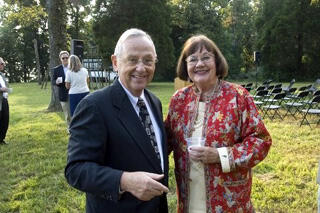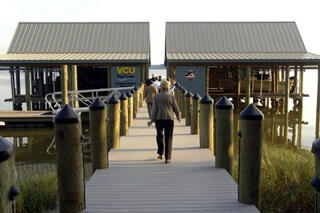Oct. 3, 2006
VCU Officials Dedicate Research Pier at the Rice Center
Share this story


The Virginia Commonwealth University Rice Center for Environmental Life Sciences has opened its metaphorical “front door” with the dedication of a new, 5,100-square-foot research pier that gives scientists direct access to the environmentally and historically significant tidal James River.
The pier, located at the Rice Center in Charles City County, was developed in partnership with the Virginia Department of Game and Inland Fisheries, and sits below a bluff on the Rice Center, an ecologically rich, 343-acre parcel of land located on the north bank of James River, southeast of Richmond. VCU Life Sciences uses the property for research, education and outreach activities.
“We regard this pier as the front door to the Rice Center,” said Thomas F. Huff, VCU’s vice provost for Life Sciences. “This will enable us to do the environmental research that will bring us national standing.”
At a cost of $850,000, the facility consists of a T-shaped pier with two boathouses, each with slips for three boats. One boathouse will be used by VCU, the other by the DGIF. An attached floating platform dock can accommodate visiting boats and the loading of research equipment.
The facility was developed in accordance with the University’s 2004 Master Site Development Plan and designed to be reminiscent of river boathouses yet reflect the research and educational mission of the Rice Center.
VCU President Eugene P. Trani, Ph.D., spoke at the dedication ceremony on Sept. 27, and reflected upon the day in 2000 when Inger Rice approached him about her parcel of land.
“She told me she had 340 acres on the James and didn’t know what to do with it,” Trani said. Trani motioned to the bluff, which overlooks the river, and told the crowd that all the research and educational outreach was a result of that gift from Mrs. Rice.
He also reflected on VCU’s commitment to the people of Charles City County.
“What this site is all about is collaboration,” Trani said, pointing out that before VCU went into Charles City County it vowed a relationship with the residents.
“If we get involved in Charles City County, the students, the faculty and the teachers of the county are going to be our partners,” he said.
As a result, Rice Center scientists conduct teacher training workshops with science educators throughout the county, and K-12 students have been to the site for various activities, including building warbler boxes for research projects and helping with water monitoring. In addition, the children of Charles City County participate with students from all over Virginia in summer science programs conducted at the center.
Leonard A. Smock, director of the VCU Rice Center, said the pier will allow for greater research into the dynamics of large rivers.
“What a perfect setting for the Rice Center and its mission,” he said.
Also speaking at the dedication were the Hon. L. Preston Bryant, Virginia Secretary of Natural Resources; Col. W. Gerald Massengill, interim director, Virginia Department of Game and Inland Fisheries; and Randolph L. Gordon, M.D., chairman, VCU Rice Center Board of Trustees.
The pier is dedicated to Gordon’s late father, Raymond Lee Gordon Jr., who was director of the YMCA Camp Weyanoke located on the site from 1953 until 1975, when the property was purchased by the Rice family.
Subscribe to VCU News
Subscribe to VCU News at newsletter.vcu.edu and receive a selection of stories, videos, photos, news clips and event listings in your inbox.










